Abstract
Over 2 million tonnes of ceramic waste are generated annually in South Africa, with the majority disposed of in landfills, contributing to environmental degradation. Meanwhile, researchers are actively seeking sustainable alternatives to Portland cement (PC), which is associated with significant environmental challenges. Ceramic waste powder (CWP) refers to finely milled ceramic waste and powder derived from the polishing and finishing stages of ceramic production. This review examines the potential of CWP as a partial replacement for PC in concrete, focusing on its effects on workability, mechanical durability, and microstructural properties. The findings indicate that moderate replacement levels (up to 20%) enhance the compressive and flexural strengths of concrete. However, these benefits are not consistently reported across all studies. Additionally, CWP improves the microstructural properties of the concrete. This is probably due to the pozzolanic reactions of CWP, which result in a denser concrete matrix and enhanced long-term durability. Notable durability benefits include reduced water absorption, increased resistance to chemical attacks, and improved thermal insulation. However, the performance of concrete with higher CWP replacement levels (above 30%) remains unclear. Some studies have reported strength reductions and increased susceptibility to durability loss at this level. Further studies should focus on clarifying its pozzolanic reactivity, durability in aggressive environments, and optimum replacement percentage.
1. Introduction
Portland cement (PC) is increasingly considered unsustainable due to its significant negative environmental impact, accounting for approximately 8% of global CO2 emissions [1]. To mitigate this issue, waste materials such as ceramic waste powder (CWP) have gained recognition as promising alternatives to reduce the environmental hazards associated with PC [2]. According to a study by Umar et al. [3], incorporating 30% CWP as a partial replacement of cement in concrete can lead to a 30% reduction in CO2 emissions.
The use of ceramic waste in concrete is generally considered environmentally beneficial, although concerns such as boron leaching require careful examination [4,5,6]. Ceramic waste, especially from tile production, often contains small amounts of boron compounds, such as boron oxide (B2O3), which help reduce sintering temperatures during ceramic manufacturing [7]. Although boron is beneficial in ceramic production, its presence in large amounts can be toxic to ecosystems if it leaches into the environment [8]. However, research indicates that the boron content in ceramic wastes, often used in concrete, is generally low, typically ranging from 0–1.3% B2O3, posing minimal environmental risk at these concentrations [9]. Studies have also shown that ceramic waste derived from tiles, sanitary ware, and other domestic sources exhibits negligible leaching properties, making it a safe material for construction applications [10,11]. Therefore, the use of ceramic waste benefits the environment without posing any major risk of toxicity [11].
CWP has several distinct advantages over traditional supplementary cementitious materials (SCMs) in terms of cost and sustainability. Unlike fly ash, whose availability is declining due to the global reduction in coal-fired power generation, CWP is expected to remain abundant as industrial and ceramic manufacturing activities continue to grow [12,13]. This ensures a more stable and predictable supply. Researchers have also established that CWP can lower concrete production costs. For instance, Raval et al. [14] found that replacing 30% of PC with CWP reduced cement costs by 12.67% in Iran [14]. Additionally, some SCMs, like metakaolin, require energy-intensive processing, including the controlled calcination of kaolin clay, which increases both production costs and carbon emissions [15]. In contrast, CWP is a post-industrial waste material that does not require further thermal treatment, making it more environmentally friendly and energy-efficient. These advantages position CWP as a promising and practical alternative for sustainable concrete production in the long term.
Generally, ceramic waste materials have gained significant attention due to their practical applications in sustainable construction practices [15]. A diverse range of studies has highlighted the potential of ceramic waste as a substitute for aggregates or SCMs [2,16,17,18]. Doss et al. [16] explored the use of ceramic tile waste as a filler to enhance the thermal insulation of concrete. Similarly, Daniyal et al. [19,20,21,22,23] replaced aggregates with crushed ceramic tile waste in structural concrete, harnessing its mechanical viability. These studies emphasise improved durability and sustainability.
Previous studies have broadly reviewed ceramic waste, often as a combined replacement for aggregates and cement in concrete. In contrast, this study specifically examines CWP as a cement replacement material. It provides a comprehensive review of the key properties of CWP concrete, examining various characteristics, such as workability, compressive strength, tensile strength, flexural strength, durability, and concrete microstructure. Furthermore, this study considered multiple factors that could influence the outcomes, offering a detailed and nuanced understanding of the behaviour and potential of CWP in concrete applications. Some researchers have obtained CWP from the final cutting and polishing stages of ceramic manufacturing. Others produce it by crushing and milling ceramic waste (tiles, sanitary ware, and tableware) into powder. Despite the different sources, the chemical composition of CWP is consistent [2,12,24,25,26,27]. Figure 1 shows an image of the CWP obtained from ceramic cutting and polishing, while Figure 2 shows the CWP obtained by crushing and milling ceramic waste.
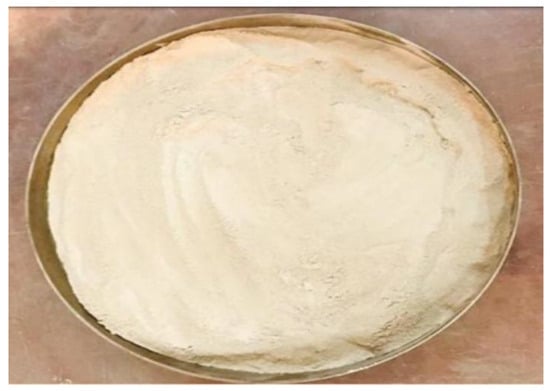
Figure 1.
CWP obtained from the final cutting and polishing stages of ceramic production [28].
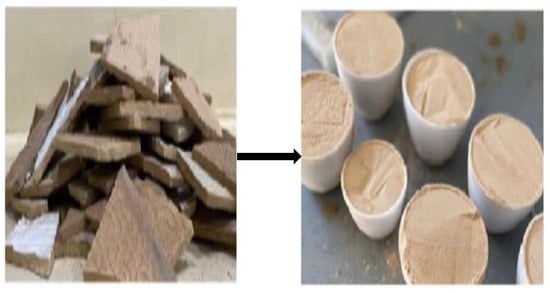
Figure 2.
CWP obtained by crushing and milling ceramic tiles into powder [29].
Researchers often use CWP as a pozzolanic material, like ground granulated blast furnace slag (GGBS), fly ash, or silica fume, or as an inert filler, like limestone powder in concrete. When CWP is used in high quantities, such as replacing up to 50% of PC, researchers aim to observe whether it behaves as a pozzolanic material [2]. This expectation is reasonable, given that microstructural analyses frequently report that CWP contains high levels of silica (up to 65 %). Silica is crucial for pozzolanic reactions, where it combines with calcium hydroxide (CH) to form calcium silicate hydrate (C−S−H) gel, the main binding component in cement, contributing to its strength and durability [24,25]. This reaction also helps mitigate the alkali-silica reaction (ASR) in concrete. In contrast, researchers have used smaller amounts of CWP, typically 10% PC replacement or less, expecting it to act more like an inert filler, which improves concrete durability by densifying the concrete matrix [30,31].
The production processes that ceramic waste undergoes significantly affect the reactivity of the silica in its composition [32]. Consequently, silica may lose its pozzolanic reactivity, causing CWP to behave more like an inert filler than a reactive material. This raises a valid argument over the role of CWP in concrete—whether it acts as a pozzolan that contributes to hydration products and improves mechanical properties or as an inert filler that enhances concrete durability simply by filling the pores in the concrete microstructure. It is also important to note that other properties, such as the specific surface area of the powder, also play an important role in the reactivity of CWP in concrete [33].
Although many studies have shown consistent results regarding the performance of CWP concrete, some contradictions remain in the literature. Several studies have suggested that CWP exhibits lower strength at early ages but eventually gains strength comparable to that of PC concrete at later ages [24,25,34]. These Researchers observed that CWP concrete showed lower strength at 7 days but achieved higher strength at 28 to 90 days, similar to pozzolanic concrete [24,25,26,27]. Pozzolans like fly ash, GGBS, and silica fume are known for their slower hydration rates, which initially result in lower compressive strength but lead to stronger and more durable concrete over time as additional C−S−H forms [33]. This delayed strength development is a basic characteristic of pozzolanic materials, as highlighted by Mehta and Monteiro [33]. However, some researchers have reported little or invariable strength development (compared to PC concrete) with no long-term strength improvement. These studies also observed improved durability at later curing ages. This suggests that CWP behaves similarly to inert materials like limestone powder.
1.1. Manufacturing of Ceramics
This study reviews concrete made with ceramic waste, such as tiles, sanitary ware, and tableware. These are primarily composed of oxide ceramics, such as silica and alumina [35,36]. The manufacturing of oxide ceramics follows a series of well-defined steps to transform raw materials into finished products. The raw materials include kaolin, ball clay, silica, sand, and feldspar [36]. During manufacturing, these raw materials undergo various thermal and mechanical processes that refine them. These processes also alter the physical and chemical properties of the waste, ultimately influencing the composition and reactivity of the resulting ceramic waste [36].
Sintering (firing) is crucial for converting ceramic raw materials into dense, connected microstructures [32,37]. For oxide ceramics, sintering is performed at temperatures ranging from 1000 °C to 1400 °C based on the product’s exact composition and required properties [37]. These high temperatures facilitate chemical reactions and phase transformations, leading to the densification and consolidation of ceramic materials [38]. This process may significantly affect the reactivity of oxide ceramics by altering their chemical and structural properties [38]. Some oxides undergo various reactions at elevated temperatures, enhancing their bonding and densification [36]. For example, when feldspar (KAlSi3O8) is used as a flux, it partially melts and forms a liquid phase that assists in bonding adjacent silica (SiO2) and alumina (Al2O3) particles [39]. This reaction aids the formation of mullite (3Al2O3⋅2SiO2), a crystalline phase that improves the mechanical strength and thermal stability of ceramics [39]. At the same time, impurities such as iron oxides (Fe2O3) can undergo reduction or oxidation reactions depending on the kiln atmosphere, affecting the colour and reactivity of the ceramic. Hence, sintering reduces the porosity of the ceramic body, which, in turn, lowers the surface area available for chemical interaction [39,40]. This can decrease the reactivity of oxide ceramics when they are reused, for example, in concrete as SCM. During the rehydration of recycled ceramic powder in concrete, the densified structure may slow down the reactions between the ceramic material and CH from the cement paste. This may cause CWP to behave like an inert cement filler when used in concrete despite its high silica content.
1.2. Characteristics of CWP
According to the literature, CWP is typically cream or brownish in colour, with a fine and granular texture [24,25,26]. Table 1 provides a detailed comparison of the physical characteristics of CWP and PC from different studies. CWP, with specific gravities ranging from 2.53–2.97, tends to have lower densities than PC, which typically ranges from 3.10–3.15. This indicates that CWP is lighter than conventional cement. The bulk density of CWP ranged from 2.56–2.97 g/cm3, while that of PC typically falls within the range of 1.44–1.60 g/cm3. The specific surface area of CWP used in the literature varies widely, from as low as 365 m2/kg to as high as 34,100 m2/kg. This shows the high variation in the sizes of the powder used by different researchers. In comparison, PC usually has a specific surface area between 300 and 400 m2/kg. The water absorption of CWP was found to be 0.1% by Mohit et al. [25], which is an advantage in concrete, as it suggests low porosity. In contrast, PC has a slightly higher water absorption range of 0.25–0.30%. Finally, an autoclave expansion of 0.08% was observed for CWP by Heidari et al. [41], while PC typically shows an expansion of 0.80% [42].
Regardless of their source, the chemical compositions of different types of ceramic waste are similar [12,34,43]. Microstructural analyses have also established similarities between the chemical compositions of fired ceramic products and their raw materials, with differences primarily in the mineral composition post-heating [12]. Table 2 presents the chemical compositions of the CWP samples. CWP exhibits a distinct chemical composition compared to PC, primarily due to its high silica (SiO2) and alumina (Al2O3) content and low calcium oxide (CaO) content [44]. The silica concentration in CWP ranges from 57% to 66%, which is significantly higher than the 17–25% typically found in PC [33,42,45,46,47]. This high silica content suggests that CWP could serve as a pozzolanic material in cement blends, enhancing long-term strength through secondary hydration reactions. Amorphous SiO2 in concrete reacts with CH, which is a byproduct of cement hydration. This is a secondary reaction (pozzolanic reaction) that occurs after hydration. This reaction produces additional C–S–H, which is a key strength-contributing phase in concrete [33]. This pozzolanic reaction can lead to strength improvements of 10–30%, depending on the pozzolan type, replacement level, and curing conditions. Al2O3 in CWP contributes to early age strength and durability by forming calcium aluminate hydrates (C–A–H) and calcium aluminosilicate hydrates (C–A–S–H) [48]. These compounds improve the microstructure and early strength gain. Additionally, CWP contains 18–22% Al2O3, which is much higher than the 3–8% usually observed in PC, potentially benefiting early strength. Al2O3 enhances the chloride binding capacity by forming Friedel’s salt, which immobilises chlorides and mitigates their ingress [48,49]. This property is especially valuable in aggressive environments, such as marine or dicing conditions, where chloride-induced corrosion is a concern. According to El-Dieb et al. [50], the chemical composition of CWP meets the American Society for Testing and Materials (ASTM) C618 [51] requirements for natural pozzolans, indicating its potential as an SCM. However, the low CaO content (2.5–7.4%) in CWP indicates that it lacks the necessary calcium for primary cementitious reactions, limiting its use as an independent binder.
Minor oxides, such as iron oxide (Fe2O3) and sulphur trioxide (SO3), vary in CWP samples but generally fall within the typical range for Portland cement. Fe2O3 in CWP does not significantly affect hydration because it is not highly reactive. The SO3 content ranges from 0 to 3.01%; small amounts may cause flash settings, while excessive SO3 can delay settings. Figure 3 presents the EDS analysis of the CWP.
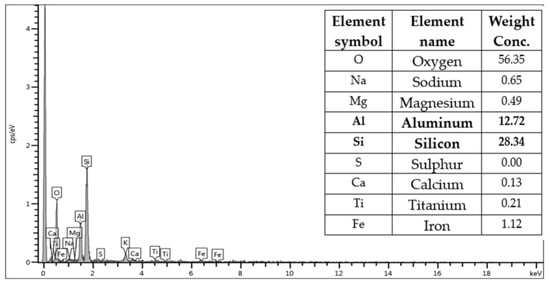
Figure 3.
EDS analysis of CWP.

Table 1.
Physical characteristics of CWP in cement.
Table 1.
Physical characteristics of CWP in cement.
| Reference | Specific Gravity | Bulk Density (g/cm3) | Specific Surface Area (m2/kg) | Autoclave Expansion (%) | Water Absorption |
|---|---|---|---|---|---|
| [41] | 2.57 | 0.08 | |||
| [25] | 2.78 | 887 | 0.1 | ||
| [52] | 2.56 | 458 | |||
| [52] | 2.97 | ||||
| [53] | 2.65 | 365 | |||
| [54] | 2.61 | ||||
| [55] | 2.53 | ||||
| [29] | 2.56 | ||||
| PC [33,45,46,47] | 3.10–3.15 | 1.44–1.60 | 300–400 | 0.80 | 0.25–0.30 |

Table 2.
Chemical composition of CWP and PC.
Table 2.
Chemical composition of CWP and PC.
| Reference | Al2O3 | CaO | SiO2 | Fe2O3 | SO3 | Na2O | K2O | TiO2 | P2O5 | MnO | MgO | L.O.I. |
|---|---|---|---|---|---|---|---|---|---|---|---|---|
| [41] | 21.8 | 5.1 | 64.8 | 3.9 | 2.0 | - | - | - | - | - | 1.7 | 1.3 |
| [25] | 22 | 4 | 65 | 5 | 1.5 | 0.25 | 1 | - | - | - | 1 | - |
| [56] | 20.47 | 5.90 | 59.64 | 4.80 | 2.08 | 0.80 | - | - | - | - | 2.74 | 1.97 |
| [57] | 21.77 | 2.59 | 57.01 | 0.65 | 2.41 | - | - | - | - | - | 2.71 | 1 |
| [52] | 20.64 | 6.30 | 58.47 | 3.40 | 2.04 | 0.74 | - | - | - | - | 2.45 | 1.88 |
| [53] | 21.5 | 4.6 | 66.6 | 2.8 | 2.7 | - | - | - | - | - | 1.2 | 3 |
| [58] | 22.18 | 7.35 | 63.71 | 3.83 | - | 0.28 | 0.11 | 0.13 | - | 0.04 | 0.95 | 1.6 |
| [59] | 20.91 | 6.32 | 65.06 | 2.8 | 2.06 | - | - | - | - | - | 2.75 | 1.56 |
| [60] | 21.33 | 5.43 | 60.3 | 3.88 | 0.183 | - | - | - | - | - | - | - |
| [61] | 18.89 | 4.24 | 62.37 | 3.83 | 2.31 | 0.12 | 1.14 | 0.31 | 0.12 | 0.07 | 0.99 | 1.52 |
| [26] | 18.37 | 4.26 | 64.04 | 3.89 | 3.01 | 0.12 | - | - | - | - | 1.52 | 4.23 |
| [29] | 22.31 | 6.67 | 61.62 | 1.24 | 0.07 | 0.96 | 1.55 | - | - | - | 0.65 | 3.96 |
| PC: [33,42,45,46] | 3–8 | 60–67 | 17–25 | 0.5–6 | 1–3 | 0.1–1 | 0.1–1 | 0.1–0.2 | 0.1–0.2 | 0.1–0.2 | 0.5–4 | 2–4 |
Despite the high silica content of CWP, its reactivity in concrete remains uncertain [2]. As such, it remains unclear whether CWP functions effectively as an SCM (pozzolanic material) or merely as an inert cement filler [2]. Apart from PC clinker, which is a constant constituent of all types of PC, other cement materials can be classified as either SCM or inert filler materials [62]. According to SANS 50197-2013 [62], chemically active materials like GGBS are classified as SCMs, while inert materials like limestone are considered fillers. According to John et al. [31], fillers are fine particles that produce little or no pozzolanic reactions in cement hydration when added to cement or other SCM. Fine fillers are used in cement to occupy spaces that would otherwise be filled with water, allowing for a lower water-binder ratio and reducing concrete permeability [31]. Fine fillers are valuable ingredients in modern construction practices because they enhance concrete performance without inducing any reaction. In addition to the filler effect (optimisation of particle packing by reducing voids between larger particles in concrete), fine fillers mitigate drying shrinkage, reduce cracking, and increase the long-term durability of concrete. In contrast, SCMs contribute to the production of more cementitious compounds due to their pozzolanic reactivity, which increases the strength and durability of concrete. SCMs are usually used to replace PC clinkers at a higher percentage than fillers [43,62]. However, researchers have yet to clearly establish whether CWP functions more effectively as an SCM or as an inert cement filler in concrete.
2. Methodology
This systematic literature review evaluates the potential of CWP as a partial replacement for PC in concrete, with particular emphasis on its effects on workability, mechanical properties, durability, and microstructure characteristics. A structured and rigorous methodology was employed to ensure the relevance, transparency, and reproducibility of the review process.
This review focused on studies published between 2010 and 2024, prioritising peer-reviewed journal articles, conference proceedings, and credible industry reports that investigated the influence of CWP on concrete performance. A comprehensive search was carried out using Scopus, Web of Science, ScienceDirect, SpringerLink, and Google Scholar. Keywords included “Ceramic Powder Concrete”, “ceramic wastes concrete powder cement”, “sustainable concrete materials”, and “durability and mechanical properties of concrete containing ceramic powder”, among other related terms.
The searches yielded 51 results from Scopus, 43 from Web of Science, 48 from ScienceDirect, 23 from SpringerLink, and 69 from Google Scholar databases. Figure 4 shows the Analysis of the 51 documents found on Scopus. After removing duplicates, 196 unique articles were included. Language filters were applied to limit the selection to English-language publications, reducing the number of publications to 187. These include studies on various ceramic sources, such as bricks. To refine the scope, studies were selected based on specific inclusion criteria: the use of CWP derived from tiles and sanitary ware, the provision of quantitative data on concrete properties, and the application of experimental or analytical methods. Articles that lacked empirical data or focused on other types of ceramic waste were excluded, resulting in the final selection of 115 papers.
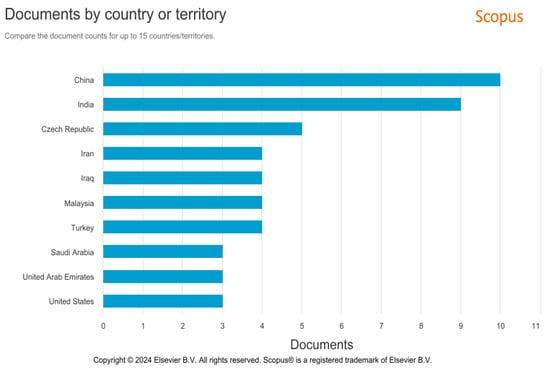
Figure 4.
Analysis of 51 documents found on Scopus for KEY (ceramic AND wastes AND concrete AND powder AND cement).
Data were systematically extracted, capturing details such as concrete mix proportions, replacement levels, measured properties (e.g., compressive strength and durability indices), and experimental conditions. The findings were categorised into thematic groups to identify trends, patterns, and inconsistencies. A critical quality assessment of each study ensured that only methodologically sound research with complete and reliable data was included in the synthesis process. The qualitative findings were summarised and compared, while quantitative analysis was performed for properties such as compressive strength.
3. Results
3.1. Effects of CWP on Concrete Workability
Concrete workability refers to the ease of mixing, placing, and compacting without segregation or excessive bleeding [63]. This property significantly affects the quality and performance of hardened concrete. Numerous factors influence workability, with the water-binder ratio being the most critical. The type of cementitious material used also plays a vital role. Finer cementitious materials enhance workability while reducing bleeding and segregation [64]. Various Supplementary Materials have been employed to improve the workability of fresh concrete. For example, fly ash enhances workability, whereas materials like steel or synthetic fibres tend to reduce it [64]. The most common method for assessing concrete workability is the slump test. Table 3 provides an overview of the workability of the CWP concrete.
The impact of CWP on concrete workability varies among studies. Generally, most findings indicate a decrease in slump as the CWP content increases. For instance, Daniel et al. [65] reported a reduction from 110 mm at 0% CWP to 95 mm at 30%, while Attaelmanan et al. [28] recorded a sharper decline from 135 mm to 65 mm at 20% replacement. Li et al. [44] also noted a significant 52.4% slump loss at 20% CWP, attributing it to increased particle friction. Nevertheless, some studies have reported contrary results. Abubakr et al. [66] observed a significant improvement in workability with finer CWP, and Sondarva et al. [57] found an increased slump with bacterial additives. These inconsistencies likely stem from variations in the CWP particle size, additives, and admixtures. Finer particle sizes, such as those passing ASTM sieve #200 or ranging between 5 and 10 µm, tend to increase water demand and reduce workability due to higher surface area and inter-particle friction [66]. Similarly, the angular and rough textures of the CWP particles intensify the internal friction within the mix, contributing to the slump loss. However, this effect can be moderated by the use of additives. For instance, superplasticisers like naphthalene-based Ceraplast-300 or sodium silicate (Na2SiO3) reduce water demand and improve dispersion, partially countering the stiffening effect of CWP [67]. Biological additives, like Bacillus megaterium, have also shown a positive effect on slump.

Table 3.
Overview of studies on the workability of CWP concrete.
Table 3.
Overview of studies on the workability of CWP concrete.
| Reference | Average Particle Size | Type of Additive | Percentage Replacement | Water/Binder Ratios | Source of CWP | Effect of CWP on Concrete Workability |
|---|---|---|---|---|---|---|
| Daniel et al. [65] | Not specified | Ceraplast-300 (naphthalene-based superplasticiser, 0.2%) | 0%, 5%, 10%, 15%, 20%, 25%, 30% | Not specified | CWP from dressing and polishing of ceramics. | Slump decreased from 110 mm (0% CWP) to 95 mm (30% CWP). Compaction factors also decreased from 0.92 (0% CWP) to 0.87 (30% CWP). |
| Tahir et al. [67] | Not specified | Na2SiO3 | 0%, 10%, 20%, 30%, 40%, 50%, 60% | Not specified | Ceramic wall tiles waste. | Slump decreased generally; however, slump increases at 10 and 40% replacement in Mix 1. The inclusion of Na2SiO3 in Mix 2 further reduces slump. |
| Attaelmanan et al. [28] | Below 1 mm | None | 0%, 10%, 15%, 20% | Not specified | CWP was obtained from a ceramic factory. | Slump decreased as CWP content increased, starting at 135 mm (0% CWP) and decreasing to 65 mm (20% CWP). |
| Kannan et al. [68] | Not specified | None | 0%, 10%, 30% 40% | Not specified | CWP was obtained from the final polishing process of ceramic products. | Slump decreased initially with increased CWP; improved slump at 20% and 30% CWP. Higher CWP levels (40%) exhibit significant slump loss. |
| Sondarva et al. [57] | Not specified | Bacillus megaterium (bacterial additive) | 0%, 5%, 10%, 15%, 20% | Not specified | Ceramic tile waste powder | Slump increased from 80 mm (0% CWP) to 105 mm (20%). |
| Abubakr et al. [66] | Finer particles passing through ASTM sieve #200 | None specified | 0%, 10%, 20% | 0.38 | CWP from a local ceramic factory | Workability increased significantly with CWP content; doubled that of control mixes at 20%. |
| Li et al. [44]. | Majority of particles fall between 5–10 µm | Superplasticizer added. (Type not specified) | 0%, 10%, 20% | 0.40 | CWP was obtained from ceramic tiles manufacturer. | Control mix slump is 105 mm; slump decreased by 33.3% at 10% CWP and 52.4% at 20% CWP due to increased friction between particles |
| Huseien et al. [69] | Median particles of 35 µm | None | 0–80% | Not specified | Not specified | Increased slump flow and workability with higher CWP content (50–80% CWP meets EFNARC SCC criteria). |
Daniel et al. [65] tested the slump of concrete containing CWP at 0, 5, 10, 15, 20, 25 and 30%. The researchers revealed that as the proportion of CWP increased, there was a noticeable decrease in the workability of the concrete mixture. The researchers suggested that the workability of CWP concrete is enhanced only with superplasticisers. This agrees with the findings of Attaelmanan et al. [28], who found that mixtures with CWP have a relatively lower slump than the reference mix without CWP. The addition of CWP to the cement decreased the concrete slump, as shown in Figure 5.
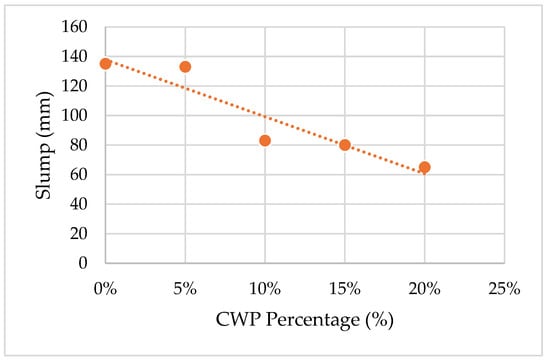
Figure 5.
Attaelmanan et al. Slump test results [28].
Tahir et al. [67] investigated concrete containing CWP at 0–60% in steps of 10%. The study comprised the formulation of three distinct concrete mixtures: one without silicate (Na2SiO3), and two with 1% and 2% Na2SiO3 of the binder. The researcher’s findings showed that in Mix 1, the slump value decreased compared to that of conventional concrete. However, when 10% and 40% of CWP were used as a replacement, the slump value increased by 3.03% and 6.06%, respectively. In Mix 2, which contained 1% Na2SiO3 in the binder, the slump value generally decreased, except at 10% and 40% CWP. The research indicates that the addition of CWP can have varying effects on the workability of CWP concrete. Including Na2SiO3 in Mix 2 led to a further reduction in slump, underscoring the importance of precise mixing proportions to achieve the desired workability in CWP concrete.
Kannan et al. [68] investigated high-performance concrete containing CWP at 0–40% cement replacements. The researchers found that as the CWP replacement level in concrete increased, the initial slump value decreased, except for the 20% and 30% replacement levels. This decrease was attributed to the higher specific surface area of CWP, which was 1.5 times greater than that of cement. Furthermore, slump values decreased with time due to cement hydration, with the control mixture losing all slump within 60 min. However, the mixtures containing CWP demonstrated improved slump retention, with slump values reaching zero only around 120 min for the 20% replacement level. This improved slump retention was attributed to the limited immediate hydraulic reaction of CWP due to its low CaO content. Notably, the 40% CWP mixture exhibited a slump loss trend similar to that of the control mixture, possibly due to the very high surface area of CWP, especially at higher replacement ratios.
Li et al. [44] found that the slump value of concrete decreases significantly when cement is partially replaced with CWP (Figure 6). Replacing 10% and 20% of cement with CWP resulted in slump decreases of 33.3% and 52.4%, respectively. The researchers stated that the irregular angular shape and higher specific surface area of CWP increased the friction between particles, leading to reduced slump values. The researchers also recommended the use of superplasticisers for CWP concrete to increase the slump value and workability by reducing the internal friction among concrete particles. Comparatively, a similar study by Patel et al. [70] reported smaller changes in slump values with CWP increment, likely due to higher water/binder ratios and differences in aggregate properties used in their experiments [44]. These factors can also affect the workability of concrete.
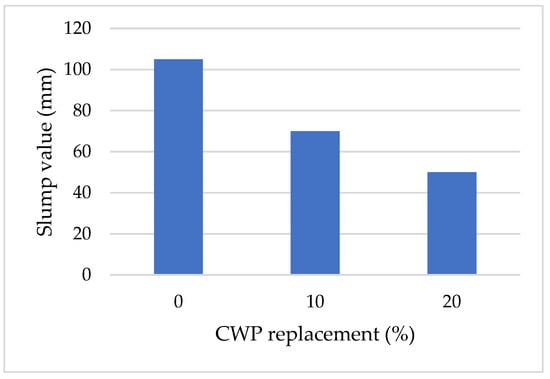
Figure 6.
Slump test values of concrete specimens at different CWP replacement ratios of cement [44].
Huseien et al. [69] conducted three tests—slump flow, T50, and L- box to evaluate the impact of CWP on the filling ability of self-compacting concrete (SCC). Figure 7 shows the slump flow results. In contrast to compacted concrete, the slump flow test showed a significant increase in concrete workability with a higher CWP content replacing GGBS. As the CWP content increased from 0% to 80%, the flow diameter expanded from 560 to 780 mm, indicating enhanced flowability. The researchers stated that concrete mixes with 50–80% CWP met the European Federation of National Associations Representing Producers and Applicators of Specialist Building Products for Concrete (EFNARC) criteria for SCC. The T50 test results also reflected these findings. According to the study, concrete specimens demonstrated improved workability as the T50 time decreased from 6 s to 2.5 s with increasing CWP content. Mixes with 40% or more CWP replacement also met the EFNARC standards for SCC. The L-box test further confirmed these results, showing that all samples, except those with 0% and 10% CWP, passed the SCC requirements. The increased flowability was attributed to the larger particle size distribution and lower specific surface area of CWP compared to GGBS, as well as the lower water demand of CWP, which enhanced plasticity and workability by affecting the chemical reaction rate.
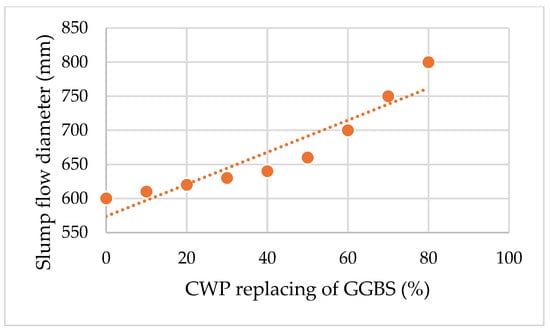
Figure 7.
Slump flow of SCC containing different ratios of CWP replacing GGBS [69].
3.2. Effects of CWP on Concrete Mechanical Properties
Table 4 provides a detailed overview of studies on the effects of CWP on the mechanical properties of concrete. Compressive strength— the critical parameter in concrete load-bearing applications–varies notably depending on the percentage replacement of CWP and particle size. Most studies have identified optimal replacement levels between 10% and 30% to achieve enhanced or comparable performance to PC concrete.
The enhanced performance of CWP concrete is usually attributed to the pozzolanic reactivity of CWP. Pozzolanic reactivity is the ability of a material to chemically interact with CH, a byproduct of cement hydration, in the presence of moisture [33]. Cement hydration is an exothermic chemical process that produces compounds such as C−S−H (the primary contributor to concrete strength), ettringite, monosulphate, and CH (also known as portlandite) [35,71,72]. Silica in CWP supposedly reacts with CH in a secondary pozzolanic reaction to form additional C−S−H, which acts as a glue that binds aggregates and other cementitious materials together [73]. This cohesion increases the overall load-bearing capacity of concrete. However, this pozzolanic reaction occurs slowly, which is why pozzolanic concretes typically exhibit lower early-age strength but higher long-term strength than conventional PC concrete [33,73].
Although pozzolanic reactivity is most accurately analysed using microstructural techniques like Scanning Electron Microscopy (SEM) to observe hydration products, the Strength Activity Index (SAI) is also a practical method [69]. The SAI measures the compressive strength of cement-CWP blends relative to PC concrete. Studies have shown that CWP concrete achieves comparable performance at optimal replacement levels due to a combination of pozzolanic activity and enhanced particle packing.
The fine particles of CWP improve the particle distribution of concrete and strengthen the interfacial transition zone (ITZ) between aggregates and cement paste [31,74]. This refined microstructure also enhances the mechanical properties of concrete [31]. However, determining whether the improved strength or durability of CWP-based concrete is due to the pozzolanic reaction or merely the result of CWP filling voids in the concrete microstructure is challenging. Therefore, the mechanical behaviour of CWP-based concrete is often clarified by analysing the composition of its microstructure.
Daniel et al. [65] and Tahir et al. [67] found that moderate (30% or below) CWP replacement levels produced enhanced mechanical properties. Daniel et al. observed that 15% replacement yielded the highest compressive, tensile, and flexural strengths in M30 grade concrete, with compressive strength rising from 34.1 MPa for conventional concrete to 38.56 MPa at 28 days as shown in Figure 8. Beyond 15%, the properties declined rapidly, possibly due to the dilution effect. Similarly, Tahir et al. identified 30% CWP combined with 2% sodium silicate as optimal for M25 grade concrete, significantly improving compressive strength while maintaining tensile strength and slightly reducing flexural strength. This study suggests that sodium silicate enhances pozzolanic activity at higher CWP levels. Both studies highlighted that moderate CWP levels optimise particle packing and pozzolanic activity, resulting in improved strength.
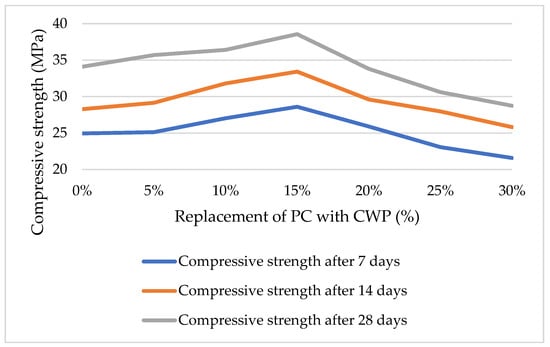
Figure 8.
Compressive strength of CWP concrete at 7, 14, and 28 days [65].
Sondarva et al. [57], Li et al. [44], and Huseien et al. [69] reported that lower CWP replacement levels (5–10%) offered peak mechanical properties. Sondarva et al. observed a 15% increase in compressive strength with 5% replacement in bacterial concrete. The researchers attributed this performance to the improved early strength development due to the CWP. This is reasonable because, in addition to SiO2, CWP contains approximately 20% Al2O3, which significantly contributes to the early strength of concrete. Similarly, Li et al. noted an 8.75% increase in compressive strength at 10% CWP, but a significant reduction in strength thereafter, as shown in Figure 9. Huseien et al. also found the maximum strength at 5% replacement, with extended curing periods allowing mixes to meet or exceed the characteristic strength.
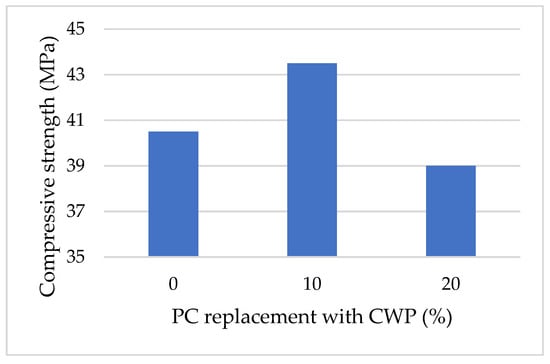
Figure 9.
Compressive strength of CWP concrete [44].
Abubakr et al. [66], Kumar et al. [75], and Rani [76] observed diminishing returns with higher CWP levels. Abubakr et al. reported significant reductions in compressive strength at 10–20% replacement. Similarly, Kumar et al. observed peak strength at 10% replacement, with a progressive decline up to 80%. This decline was linked to the reduced CWP CaO content and slowed pozzolanic reactions. Rani noted that strength peaked at 10% replacement but significantly declined beyond this level, with the steepest reduction at 50% as shown in Figure 10.
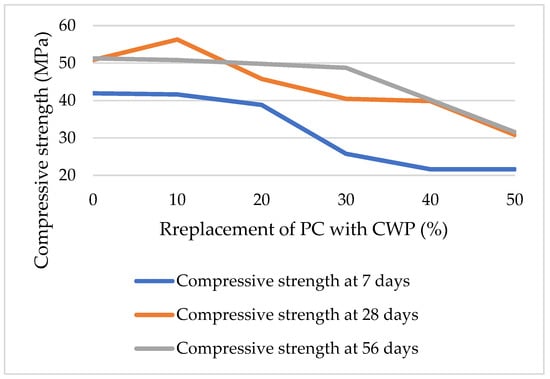
Figure 10.
Compressive strength of CWP concrete at 7, 28, and 58 days [76].
Heidari et al. [41] and Umar et al. [3] also agree that moderate CWP levels benefit long-term performance. Heidari et al. found minimal strength losses at 10–20% replacement after 91 days, demonstrating CWP’s negligible impact on long-term durability. Umar et al. confirmed that 30% replacement produced satisfactory strength at 7 and 28 days but warned of reductions at higher levels of replacement. These studies underscore the importance of maintaining replacement ratios within optimal thresholds to balance immediate performance and long-term durability.

Table 4.
Overview of the mechanical properties of CWP concrete.
Table 4.
Overview of the mechanical properties of CWP concrete.
| Author(s) | Source of CWP | Strength Class | Percentage Replacement | Average Particle Size | Curing Days | Effect of CWP on Compressive Strength | Effect of CWP on Flexural Strength |
|---|---|---|---|---|---|---|---|
| Daniel et al. [65] | Ceramic Industry Waste Powder | M30 | 5%, 10%, 15%, 20%, 25%, 30% | Not specified | 7, 14, 28 | Increases up to 15% replacement, with optimal strength at 15% after 28 days; decreases with higher replacements. | Increases up to 15% replacement, with the highest tensile strength at 15%; decreases with higher replacements. |
| Tahir et al. [67] | Ceramic Wall Tile Waste Powder | M25 | 0%, 10%, 20%, 30%, 40%, 50% | Not specified | 28 | Increases up to 30% replacement, optimal strength at 30%; decreases with higher replacements. | Minor loss in tensile strength compared to conventional concrete. |
| Sondarva et al. [57] | Ceramic Tile Waste Powder with Bacillus megaterium | M25 | 0%, 5%, 10%, 15%, 20% | Not specified | 7, 28 | Compressive strength increases with bacterial concrete: peak strength at 5% CWP, 15% higher than control; | Splitting tensile strength increases up to 13.52% with 5% CWP at 7 days. |
| Abubakr et al. [66] | Local Ceramic Factory Waste Powder | M25 | 10%, 20% | Passed through ASTM #100 sieve | 14, 28 | Compressive strength decreases by 11% at 10% CWP and 23% at 20% CWP at 28 days due to coarser particle size. | Flexural strength matches or slightly increases with CWP addition (recommended applications where flexural strength is critical). |
| Li et al. [44] | CWP from Polishing of ceramic tiles. | M40 | 0%, 10%, 20% | 5–10 µm (50% of particles) | 28 | Compressive strength increases by 8.75% at 10% CWP replacement (43.5 MPa vs. 40.5 MPa in control) due to pozzolanic reaction; decreases by 10.3% at 20% replacement. | Predicted flexural strength (using an empirical model based on compressive strength) matches control. |
| Heidari et al. [41] | Recycled Ceramic Tile Waste | M40 | 10%, 15%, 20%, 25%, 30%, 40% | ≤75 μm (200 mesh) | 7, 28, 56, 91 | Minor strength loss for 10–20% CWP replacement at 91 days, with only a 0.4 MPa reduction for 20% CWP compared to control. | Not tested. |
| Rani [76] | Ceramic Industry Waste Powder | M40 | 0%, 10%, 20%, 30%, 40%, 50% | Not specified | 7, 28, 56 | Increases up to 10% replacement, with peak compressive strength at 10% CWP at all curing ages; decreases significantly beyond 10%, with maximum reduction at 50% CWP replacement. | Not tested. |
| Kumar et al. [75] | Industrial CWP | M25 | 0%, 10%, 20%, 30% | ≤45 microns | 7, 14, 28 | Increases at 10% replacement, reaching maximum strength at 10% after 14 days; decreases beyond 10%, with 30% showing reduced strength compared to control. | Flexural strength reduces progressively with higher CWP, highest at 10% CWP; further decreases with higher replacements. |
| Umar et al. [3] | Ceramic Waste | M25 | 0%, 10%, 20%, 30%, 40%, 50% | Not specified | 7, 28 | Maximum compressive strength achieved at 30% CWP replacement; compressive strength reduces at replacements above 30%. | Not tested. |
| Attaelmanan et al. [28] | CWP from Ceramics Factory | M30 | 0%, 5%, 10%, 15%, 20% | Below 1 mm | 7, 28 | Maximum compressive strength at 5% CWP at both 7 and 28 days; all CWP mixes showed good 28-day strength development, with 20% CWP slightly below 30 N/mm2 (29.72 N/mm2). CWP slowed early strength development but achieved higher control mix strength at 28 days for all mixes except 20% CWP. | Maximum tensile strength achieved at 5% CWP. |
| Huseien et al. [69] | Ceramic Tile Powder Waste (CWP) | Not specified | 10%, 20%, 30%, 40%, 50%, 60%, 70%, 80% | Not specified | 3, 28, 56 | Compressive strength decreases with increasing CWP, with the lowest value at 80% CWP (18.6 MPa at 3 days). Strength improves with age but remains lower compared to control mix. | Not tested. |
| Parashar et al. [77] | Waste Nano Ceramic Powder and Nano-SiO2 | Not specified | Nano ceramic powder: 0%, 2%, 4%, 6%, 8%, 10%; Nano-SiO2: 0–4% | Nano particles scale. | 7, 28 | Compressive strength increased significantly with the addition of nano ceramic powder. Maximum compressive strength achieved with 6% nano ceramic powder and 3% nano-SiO2 replacement. Strength gains are minimal beyond this level. | Not tested. |
3.2.1. Effects of Replacement Levels and Particle Sizes on Compressive Strength of CWP Concrete
Several studies have observed that only low CWP replacement levels generally yield an increase in compressive strength, probably due to the limited pozzolanic ability of CWP [24,26,50,52,61,67,78,79]. At 10% replacement of PC with CWP, studies by Heidari et al., Rani, and Li et al. reported an increase in compressive strength compared to conventional concrete, with a decline observed beyond this replacement level [41,44,67,76]. Sondarva et al. and Daniel et al. noted a similar trend at 15% replacement [57,65]. Tahir et al. observed that CWP concrete exhibited compressive strength comparable to that of PC concrete for replacement levels below 30%; however, the strength decreased significantly beyond this point [57]. These findings indicate that CWP enhances compressive strength only within a limited replacement range, likely due to the low reactivity of its silica content.
It can also be deduced from the studies that particle size plays a significant role in compressive strength outcomes. For example, Heidari et al. [41] noted that CWP with particle sizes below 75 μm effectively contributes to concrete strength due to the increased surface area, which promotes the pozzolanic reaction. Parashar et al. [77] also observed that the compressive strength increased significantly with the addition of nano ceramic powder. Figure 11 shows that the maximum compressive strength was achieved with 6% nano CWP. The small CWP particles of CWP facilitate pozzolanic reactions, which enhance bonding within the cement matrix, leading to higher strength. However, when the particle size increases, the concrete’s ability to achieve strength is hindered due to reduced reactivity, as seen in studies such as that by Attaelmanan et al. 2021 [28], where decreased performance at higher replacements was observed due to increased particle size.
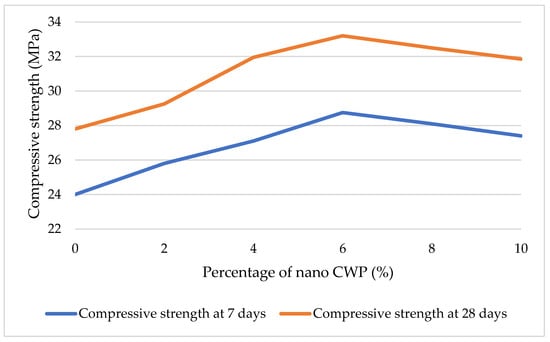
Figure 11.
Compressive strength of nano CWP concrete at 7 and 28 days [77].
3.2.2. Effects of Curing Age on the Mechanical Properties of CWP Concrete
In addition to the replacement percentage and particle size, curing age is a critical factor. The compressive strength of concrete, measured at different day intervals, provides insights into the hydration rate of the binder materials. Pozzolanic materials such as GGBS, fly ash, and silica fume tend to hydrate more slowly, leading to a gradual increase in compressive strength over time compared to PC [71,72]. This explains why pozzolanic cement concretes exhibit lower early-age strength than those made with PC [80,81]. Figure 12 and Figure 13 show the percentage change in compressive strength of CWP concrete at 7 and 28 days. The figures indicate that the compressive strength of the CWP concrete improved significantly with curing age. At 7 days, variations in strength change were observed across different replacement levels, with some studies reporting increases and others reporting reductions in strength. The strength changes ranged broadly from around +40% to −50% at this early age. However, at 28 days, the range of compressive strength changes narrowed, and the data points trended towards neutral or slightly negative changes. This suggests that CWP concrete benefits from an extended curing time, which is likely due to pozzolanic reactions contributing to strength development over time.
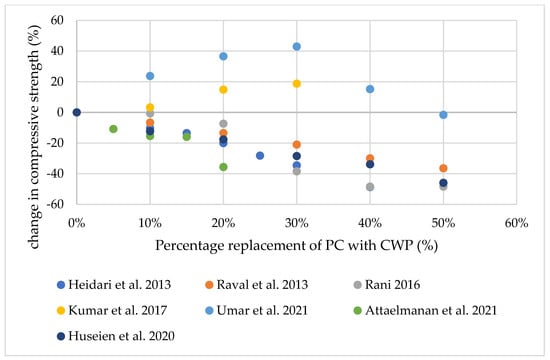
Figure 12.
Percentage change in the strength of the CWP concrete at 7 days [3,16,28,41,69,75,76].
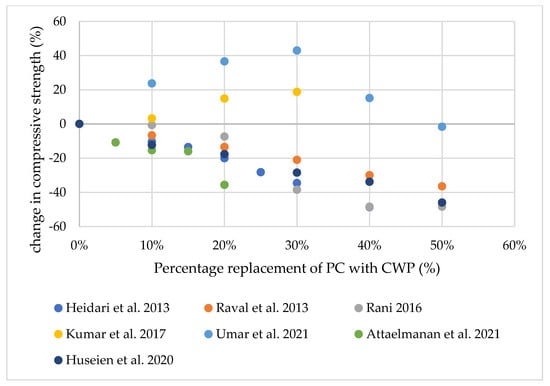
Figure 13.
Percentage change in the strength of the CWP concrete at 28 days [3,16,28,41,69,75,76].
Huseien et al. [69] report that CWP concrete mixes achieve satisfactory 28 and 56-day compressive strengths even at higher replacement levels of 20%, though strength development may be slower. This suggests that while CWP can initially inhibit early strength gain due to slower pozzolanic activity, it continues to contribute to strength development as curing progresses, ultimately meeting or exceeding the strength of PC concrete.
In contrast, Kumar and Reddy [75] observed that the compressive strength of concrete with 10% CWP peaked at all curing ages up to 28 days. However, at 28 days, the strength declined significantly for mixes with higher CWP replacements (50%), indicating that a very high CWP content may negatively affect the long-term strength. In studies where the compressive strength is measured at extended curing durations, such as 56 and 91 days [41], reported only minor strength losses for mixes with 10–20% CWP, with a 0.4 MPa decrease compared to the control at 91 days. This suggests that CWP concrete maintains satisfactory long-term durability and compressive performance, particularly at low replacement levels and with fine particle sizes.
Although the direct testing of flexural strength is limited, studies indicate trends similar to those observed for compressive strength. For instance, Sondarva et al. [57] highlighted that flexural strength tends to improve at an early curing age, with CWP replacements around 5%. Daniel and Raju (2018) [65] also observe enhanced flexural strength up to 15% CWP replacement, beyond which performance declines. This pattern suggests a limit for effective flexural performance, beyond which the CWP negatively impacts the concrete matrix. Studies such as those by Kumar and Reddy (2017) [75] and Li et al. (2024) [44] also support this, noting that CWP inclusion is suitable for applications where flexural strength is critical, provided the replacement level is carefully controlled. This improvement is consistent with the findings on compressive strength, suggesting that pozzolanic activity in CWP concrete supports both compressive and tensile strengths over time.
Overall, it can be deduced that curing age positively influences the mechanical properties of CWP concrete, especially when moderate levels (<20%) of CWP are used. Although the pozzolanic reaction of CWP is initially slower, it becomes increasingly effective with extended curing, particularly after 28 days, resulting in concrete with satisfactory or even improved mechanical performance over conventional concrete in long-term applications.
3.3. Effects of CWP on Concrete Durability Properties
Table 5 summarises the key research findings on the durability properties of concrete incorporating CWP as a partial cement replacement. Most studies have evaluated the effects of CWP on water absorption, permeability, chemical resistance, and thermal stability. The findings indicate that optimal CWP replacement levels, typically around 10–30%, can improve the durability of concrete by reducing water absorption and enhancing its resistance to chloride and chemical attacks [3,67]. Additionally, combinations such as CWP with nano-SiO2 or microbial agents show further improvements in durability, making CWP-modified concrete a promising material for use in aggressive environmental conditions [77].

Table 5.
Overview of the durability properties of CWP concrete.
3.3.1. Water Absorption, Moisture Resistance and Permeability
Water absorption is a key indicator of concrete durability. This reflects its ability to resist environmental degradation caused by moisture ingress. Studies generally show that CWP enhances the moisture resistance of concrete.
Kannan et al. [68] and Al-Ruqaishi et al. [83] reported reductions in permeability with increasing CWP content. Kannan et al. observed that concrete with up to 30% CWP replacement exhibited reduced permeable pores at 90 days of curing, although permeability increased beyond 30% replacement due to dilution effects. Similarly, Al-Ruqaishi et al. found lower sorptivity in concrete containing up to 30% CWP replacement, enhancing the resistance to moisture ingress.
El-Dieb et al. [82] demonstrated the variability in permeability reduction based on concrete strength. For concrete with a compressive strength of 50 MPa, the permeability decreased significantly at 20% CWP replacement but increased at higher levels. In contrast, concrete with strengths of 25 MPa and 75 MPa exhibited different trends, with 25 MPa concrete experiencing rapid permeability reduction beyond 20% CWP, while 75 MPa concrete showed a more gradual but consistent decrease.
The reduction in water absorption and permeability is primarily attributed to CWP’s pozzolanic activity. CWP reacts with CH during cement hydration to form additional C−S−H gel, which strengthens the microstructure by reducing the number of capillary pores. Moreover, the fine and dense CWP particles of CWP fill the voids in the concrete matrix, further limiting water ingress and enhancing durability.
Parashar et al. [77] investigated the water absorption of concrete incorporating nano CWP at 7 and 28 days. The results showed a range of water absorption capacities decreasing from 7.2% at 7 days to 6.42% at 28 days, indicating improved density and reduced porosity over time. As the percentage of nano CWP in the concrete mix increased, the water absorption also increased. This study also highlights the delayed pozzolanic activity of CWP, as significant reactions do not occur during the early curing stages, as indicated by water absorption. This suggests that CWP may initially act primarily as an inert filler, with its pozzolanic properties developing over time.
3.3.2. Chemical Resistance
The use of CWP in concrete significantly improves its resistance to chemical degradation, particularly in acidic environments. This property is critical for concrete structures exposed to aggressive conditions, such as industrial zones and wastewater treatment plants.
Tahir et al. [67] demonstrated that concrete with a 30% CWP replacement combined with 2% sodium silicate admixture exhibited remarkable durability under exposure to hydrochloric acid (HCl) and sulphuric acid (H2SO4). Their study showed that sulphuric acid caused more severe durability loss than hydrochloric acid; however, the concrete mix retained strength longer due to the denser microstructure created by the pozzolanic activity of CWP, which limits aggressive ion penetration.
El-Dieb et al. [82] highlighted that CWP reduces chloride ion penetration in concrete, enhancing resistance to chloride-induced corrosion across various compressive strengths (25 MPa, 50 MPa, 75 MPa). This improvement is attributed to the denser microstructure and refined pore system provided by the CWP.
Kannan et al. [68] also noted the impact of CWP in reducing permeable pores, further aiding the resistance of concrete to chemical attacks. However, they cautioned that higher replacement levels beyond 30% may increase porosity and reduce durability because of dilution effects.
These findings underscore the importance of optimal CWP replacement levels in achieving chemical resistance in concrete. The improved resilience to chemical attacks, whether from acids or chloride ions, highlights CWP’s potential for use in aggressive environmental conditions where long-term durability and structural integrity are critical.
3.3.3. Thermal Insulation and Fire Resistance
The inclusion of CWP in concrete enhances its thermal insulation and fire resistance properties, which are critical factors for improving structural durability in high-temperature environments.
Li et al. 2024 [44] found that concrete with up to 20% CWP replacement demonstrated a reduction in thermal conductivity by 11.2% and thermal diffusivity by 13.6%. This improved thermal insulation is particularly advantageous for buildings exposed to high temperatures or those requiring energy efficiency, as it reduces heat transfer through the structure and maintains a stable internal environment.
Additionally, the study reported that CWP-based concrete exhibits superior fire resistance. It did not undergo spalling or develop major cracks during fire exposure, demonstrating its ability to maintain structural integrity under extreme heat. This resilience is attributed to the capacity of CWP to create a denser matrix with fewer capillary pores, which reduces permeability and the risk of explosive spalling caused by the rapid vaporisation of trapped moisture under high heat.
El-Dieb et al. [82] supported these findings by highlighting that a denser microstructure, achieved with CWP incorporation, minimises the ingress of moisture and aggressive ions, which indirectly contributes to fire performance.
The combination of enhanced thermal insulation and fire resistance underscores the value of the CWP in modern concrete formulations. CWP not only contributes to structural safety in fire-prone environments but also aligns with sustainability goals by reducing the energy requirements for climate control in buildings. These benefits position CWP as a sustainable and efficient material for concrete construction, emphasising its role in achieving durability and environmental resilience.
3.4. Effects of CWP on Concrete Microstructure
Table 6 summarises the research findings on the effects of CWP on the concrete microstructure using various testing methods. Using methods such as Scanning Electron Microscopy (SEM), Energy Dispersive X-ray Spectroscopy (EDS), X-ray Diffraction (XRD), Thermogravimetric Analysis (TGA), and the Frattini test, researchers have explored how CWP enhances the microstructure of concrete. Key observations include reduced CH content due to pozzolanic activity, increased C–S–H gel formation, and improved densification of the interfacial transition zone (ITZ). The findings demonstrate the potential of CWP to refine the pore structure and contribute to stronger and more durable concrete.

Table 6.
Overview of the Key findings on the microstructural properties of CWP concrete.
3.4.1. Scanning Electron Microscopy (SEM)
Li et al. [44], using SEM at 5000× magnification, observed that CWP particles, identified as white dots, were well-dispersed within the cement matrix. Figure 14 shows the SEM image at 10% CWP replacement. The SEM image displays minimal microcracks, suggesting CWP compatibility with cement and aggregate bonding, with no significant alkali-silica reaction noted at this replacement level.
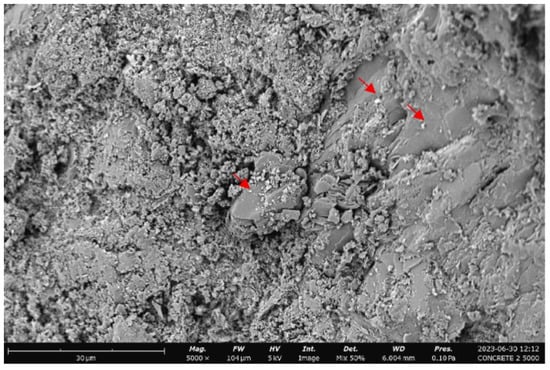
Figure 14.
SEM image of concrete with 10% CWP at 28 days [44].
Chen et al. [52] conducted SEM imaging on CWP-cement pastes. The researchers observed a denser microstructure at 10% replacement, particularly after 28 days of curing. This compactness was attributed to CWP’s pozzolanic reaction of CWP, which forms additional hydration products, reduces the pore size, and improves the microstructure.
Tawfik et al. [84] examined the effects of substituting PC with CWP on the microstructure and performance of high-strength concrete. SEM analysis of the samples after 28 days of curing revealed that concrete with 10% CWP had a less homogeneous and compact microstructure than the reference sample. The researcher observed that the roughness of the CWP particles led to stress concentrations at sharp edges, causing increased cracking and reduced strength characteristics. However, blending CWP with waste brick powder improved the compactness and reduced crack formation due to better packing of particles with different sizes and shapes.
Li et al. [56] reported that SEM EDX suggests pozzolanic reactions on CWP surfaces, particularly between the ceramic grains and hydration products. The SEM images also show a more compact ITZ, improving the overall durability by reducing the porosity within the concrete structure.
3.4.2. X-Ray Diffraction (XRD)
XRD analysis by Chen et al. [52], as presented in Figure 15, showed that CWP in cement paste reduced the CH content due to its pozzolanic reaction, forming additional C–S–H gel. The peaks for portlandite diminished with an increase in the curing days of concrete, indicating that CWP consumed CH and contributed to the pozzolanic reaction.
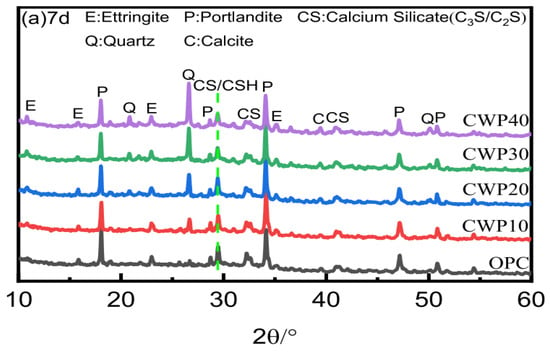
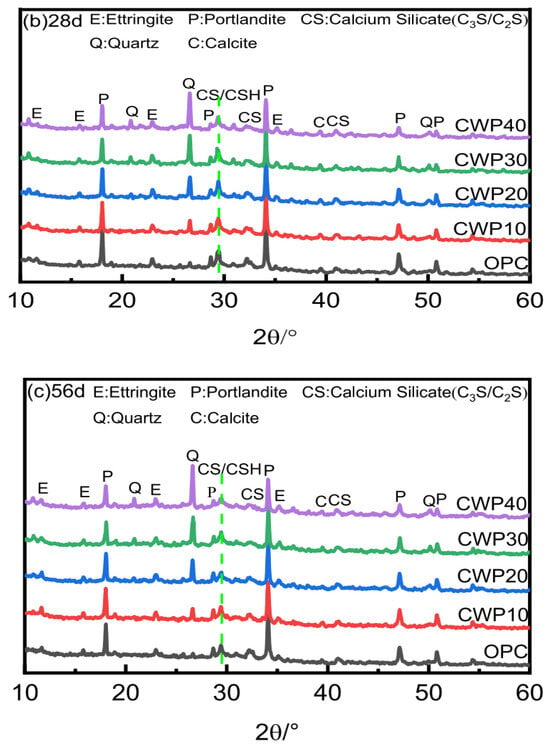
Figure 15.
XRD patterns of CWP-cement pastes. (a) XRD patterns at days (b) XRD patterns at 28 days (c) XRD patterns at 56 days [52].
Li et al. [56] observed XRD spectra of cement with CWP replacements displayed increased quartz peaks, particularly at 20–40% CWP substitution. These higher quartz levels, originating from CWP, were accompanied by reduced CH peaks over time, signifying that CWP enhanced the hydration process and aided in creating a denser microstructure.
XRD analysis by Tawfik et al. [84] revealed that CWP contributed to the formation of crystalline phases such as quartz and calcite, while portlandite levels decreased due to pozzolanic reactions. Despite its finer particle size, CWP exhibited slower pozzolanic activity than waste brick powder, which was attributed to potential recrystallisation during production and the dilution effect from cement substitution. This initially led to reduced hydration products with strong mechanical properties. However, over time, CWP concrete demonstrated significant improvements in mechanical properties, likely due to delayed pozzolanic activity and the gradual release of water from its structure, which promoted continued hydration.
XRD analysis by [68] confirmed the formation of calcium-silicate-aluminate hydrates in CWP-blended samples, where a reduction in CH was noted at 20–40% CWP replacement. The complex hydrates contributed to microstructural enhancement and reduced the porosity.
3.4.3. Thermogravimetric Analysis (TGA)
Chen et al. [52] used TGA to track mass loss stages, linking them to hydration products like C–S–H, CH, and ettringite. The results are shown in Figure 16. TGA confirmed a progressive reduction in CH content with increased curing days, supporting the XRD findings that CWP’s pozzolanic activity of CWP refines the microstructure by consuming CH and producing additional C–S–H formation.
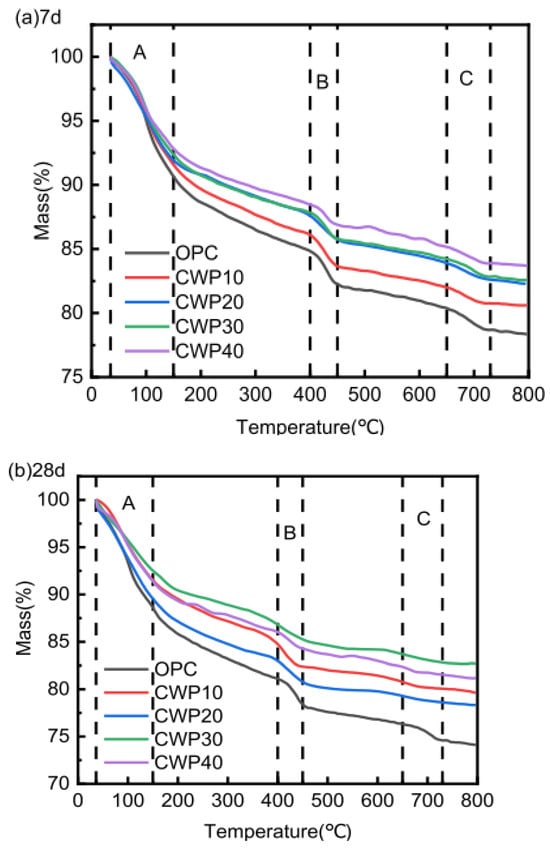
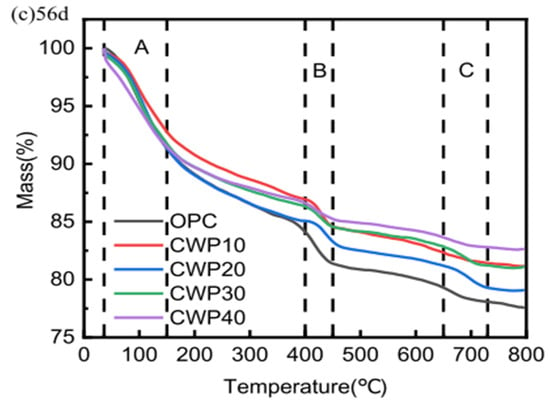
Figure 16.
TG curves of CWP-cement pastes. (a) TG curve at 7 days (b) TG curve at 28 days (c) TG curve at 56 days [52].
Li et al. [56] indicated, through TGA analysis, distinct mass loss phases: bound water evaporation and CH decomposition. The largest mass loss corresponded to the release of bound water, affirming CWP’s hydration activity. With a higher CWP content, more CH was consumed at later stages, highlighting TGA’s ability to measure the pozzolanic reactivity of CWP in the concrete microstructure.
4. Discussion
Replacing PC with CWP in concrete has numerous effects on the fresh, mechanical, and microstructural properties of concrete, including its durability. However, gaps remain in understanding the performance of CWP in concrete, particularly regarding its pozzolanic reactivity. This discussion covers the observed effects of CWP on concrete properties and highlights some contradictions found in existing studies.
The effect of CWP on the workability of concrete is inconsistent among studies. However, an increase in CWP content generally led to a reduction in slump. For instance, a decrease in slump was observed from 110 mm (0% CWP) to 95 mm (30% CWP) by Daniel et al. [65], and a more significant reduction was noted from 135 mm to 65 mm at 20% CWP replacement by Tahir et al. [67]. This is usually attributed to the fine particles in CWP, which increase the surface area and water demand, thus reducing the flowability of concrete. However, other studies have reported increased workability with CWP, especially when relatively coarser particles of CWP are used [57]. This indicates that the workability of CWP concrete depends on the particle size and the type of CWP used.
CWP generally improves compressive and flexural strengths at low to moderate replacement levels, typically up to 5–20%. For instance, Abubakr et al. [66] reported that the compressive strength increased by 8.75% within 28 days at 10% CWP replacement, and flexural strength also increased with up to 10% CWP according to Sondarva et al. [57]. These improvements are attributed to pozzolanic reactions between CWP and cement hydrates, which enhance the formation of C–S–H gel, thereby strengthening the concrete matrix. However, higher CWP content beyond 20–30% generally leads to a decrease in strength. For example, at 30% CWP replacement, the compressive strength decreases by up to 11% [66], and the flexural strength declines progressively beyond 10% CWP contents, according to Tahir et al. [67]. These findings highlight the importance of optimising the replacement level to achieve the best balance between workability and strength. The observed reduction in strength at higher replacement levels is often attributed to the coarser particle size and reduced pozzolanic activity at elevated CWP levels.
However, some studies contradict these findings. For example, some researchers have reported that CWP can enhance compressive strength by up to 30% replacement of PC [44]. This discrepancy indicates the need for further research to better understand the factors influencing CWP’s contribution to compressive and flexural strengths.
The incorporation of CWP into cement also has promising effects on concrete durability. The incorporation of CWP into concrete has been shown to enhance various durability properties, such as water absorption, permeability, chemical resistance, thermal insulation, and fire resistance [24,25,26,27,70,85]. The ability of CWP to refine the concrete matrix through its pozzolanic activity is essential for its durability. By reacting with CH in a pozzolanic reaction, CWP forms additional C−S−H gel, which densifies the concrete structure and reduces the number of capillary pores. The improved durability was also attributed to the filler effects of the finer CWP particles. This process directly improves water absorption and permeability, as highlighted by Kannan et al. [68] and Al-Ruqaishi et al. [83]. Lower water absorption reduces the ingress of harmful chemicals and moisture, thereby enhancing chemical resistance [44]. Chemical resistance, particularly in acidic and chloride-laden environments, further highlights CWP’s role in improving durability. Tahir et al. [67] demonstrated that CWP concrete performs well in aggressive environments due to its dense matrix, which limits ion penetration and structural degradation.
SEM, XRD, and TGA provided valuable insights into the effects of CWP on the concrete matrix. Li et al. [44] observed well-dispersed CWP particles within the cement matrix, which reduced microcracks in the CWP concrete microstructure. XRD and TGA results of Chen et al. [52] confirmed a reduction in CH levels and enhanced C–S–H gel formation, suggesting a pozzolanic reaction.
However, the extent of the pozzolanic reactivity of CWP in concrete remains uncertain, particularly at higher replacement levels. Some studies have reported that CWP exhibits insignificant pozzolanic reactivity beyond 10% replacement, as evidenced by the invariable CH content and slower strength development at higher replacement levels [68]. Contradictory findings have been reported by other authors who found CWP to exhibit significant pozzolanic activity even at higher replacement levels [44]. These variations may be due to differences in particle size, source of CWP, or testing method.
There is also limited data on the long-term microstructural behaviour of CWP concrete mixes, as the majority of the studies were conducted at 28 days of curing. While short-term results suggest positive pozzolanic interactions, further studies are required to assess the microstructure of CWP-based concrete over extended periods, particularly under aggressive environmental conditions like sulphate or chloride exposure.
Methodological Limitations and Research Gaps
One of the primary challenges identified in the literature is the variability in the sourcing and processing of CWP and insufficient information on the source of CWP. Although many studies indicate the origin of the CWP used, a significant number lack comprehensive characterisation of the material or fail to detail the processing methods employed in making the waste CWP. This complicates meaningful comparisons of CWP from various sources.
Another critical limitation is the inconsistent durability testing procedures. While most researchers follow recognised standards like ASTM or EN, some adopt modified or undefined procedures without sufficient explanation. These methodological inconsistencies reduce the reliability of comparative analyses and obscure a clear understanding of the durability performance of the CWP. Furthermore, although short-term performance indicators, such as compressive strength results at 28 days, are commonly reported, there is a notable lack of long-term assessments. Given the importance of long-term performance in evaluating the durability and viability of CWP as an SCM, comprehensive long-term durability testing is essential.
Additionally, the highest concrete strength level assessed in the current literature is generally limited to 40 MPa. High-strength concrete (above 40 MPa) has not been adequately investigated. Further research is therefore recommended to evaluate the performance of CWP in high-strength-concrete applications.
Lastly, most studies compare the performance of CWP solely with Portland cement. To better assess its effectiveness, it is advisable to compare CWP with conventional SCMs such as GGBS and fly ash.
5. Conclusions
The replacement of PC with CWP in concrete has been established to significantly alter the fresh, mechanical, and durability properties of the concrete. However, the potential of CWP concrete has yet to be fully realised due to certain limitations and knowledge gaps. The key conclusions and recommendations are summarised as follows:
- CWP enhances compressive strength, reduces water absorption, improves chemical resistance, and provides better thermal insulation at optimal replacement levels (typically 10–20%). A 10% substitution rate is effective for higher-strength concrete (40 MPa), while up to 20% is suitable for lower-strength concrete (<30 MPa).
- The pozzolanic activity of CWP may contribute to a denser concrete matrix, refining its microstructure and enhancing its long-term durability.
- Replacing cement with ceramic waste powder (CWP) up to 30% generally leads to a 15–30% reduction in concrete slump. However, this reduction can be mitigated by using finer CWP particles (≤35 µm) or incorporating superplasticisers. Some studies have also highlighted the effectiveness of bio-based additives, like Bacillus megaterium, in improving workability.
- Replacing 5–10% of PC with CWP typically increases the compressive strength by 5–15%, particularly in concrete with a strength class of 40 MPa and below. However, increasing the replacement level to 20% often results in a strength reduction of 10–20%. The use of nanoCWP or CWP particles finer than 35 µm can further enhance the strength by an additional 3–6%. Although the general trend is consistent, some discrepancies exist across studies, likely due to differences in CWP characteristics, mix proportions, and testing methodologies.
- Contradictory findings on the optimal percentage replacement, pozzolanic reactivity, and later-age strength highlight the need for a deeper investigation.
- Differences in the effects of CWP, such as its pozzolanic reactivity and contribution to durability, may be influenced by the particle size, chemical composition, and ceramic source of CWP.
- Further studies on the use of CWP in concrete should focus on the following aspects:
- i.
- Conducting long-term durability tests on CWP concrete in aggressive environments, including exposure to chloride. Chloride conductivity tests on CWP concrete would be helpful.
- ii.
- Investigating the pozzolanic reactivity of CWP at different replacement levels to determine its optimum percentage for balancing strength and durability.
- iii.
- Assessing the impact of CWP particle size, source variability, and its optimum particle size distribution on concrete performance.
- iv.
- Exploring the replacement of SCMs (e.g., fly ash, GGBS, silica fume, and nanomaterials) with CWP to compare the pozzolanic behaviours of CWP with those of other pozzolanic materials.
- v.
- Further testing should be conducted on high-strength concrete (above 40 MPa), as the existing literature predominantly focuses on concrete with strength classes of 40 MPa or lower.
Author Contributions
Conceptualization, P.O.A., J.O.I. and A.J.B.; methodology, P.O.A.; software, P.O.A.; validation, J.O.I. and A.J.B.; formal analysis, P.O.A.; investigation, P.O.A.; resources, J.O.I. and A.J.B.; data curation, P.O.A.; writing—original draft preparation, P.O.A.; writing—review and editing, J.O.I. and A.J.B.; visualization, A.J.B.; supervision, J.O.I. and A.J.B.; project administration, J.O.I. and A.J.B.; funding acquisition, J.O.I. All authors have read and agreed to the published version of the manuscript.
Funding
This research was funded by the Durban University of Technology South Africa Research Scholarship and Future Professor program [GOOT-02S8GT019]. And The APC was funded by the Future Professor programme [GOOT-02S8GT019].
Institutional Review Board Statement
Not applicable.
Informed Consent Statement
Not applicable.
Data Availability Statement
No new data were created or analysed in this study. Data sharing is not applicable to this article.
Conflicts of Interest
The authors declare no conflict of interest.
Abbreviations
| ASTM | American Society for Testing and Materials |
| Al2O3 | Aluminium Oxide |
| C−A−S−H | Calcium Aluminosilicate Hydrate |
| C−S−H | Calcium Silicate Hydrate |
| CH | Calcium Hydroxide |
| CWP | Ceramic Waste Powder |
| CaO | Calcium Oxide |
| EDX | Energy Dispersive X-ray |
| FA | Fly Ash |
| Fe2O3 | Iron (III) Oxide |
| GGBS | Ground Granulated Blast Furnace Slag |
| ITZ | Interfacial Transition Zone |
| K2O | Potassium Oxide |
| MPa | MegaPascal |
| MgO | Magnesium Oxide |
| N | Porosity |
| Na2O | Sodium Oxide |
| PC | Portland Cement |
| SAI | Strength Activity Index |
| SCC | Self-Consolidating Concrete |
| SCM | Supplementary Cementitious Material |
| SEM | Scanning Electron Microscopy |
| SO3 | Sulphide |
| SiO2 | Silicon Dioxide |
| STS | Splitting Tensile strength |
| TGA | Thermogravimetric Analysis |
| w/b ratio | Water/binder ratio |
| XRD | X-ray Diffraction |
| XRF | X-ray Fluorescence |
| kPa | KiloPascal |
| Kg | Kilogram |
| kg/cm3 | Kilogram per Centimetre Cube |
References
- Scrivener, K.L.; John, V.M.; Gartner, E.M. Eco-Efficient Cements: Potential Economically Viable Solutions for a Low-CO2 Cement-Based Materials Industry. Cem. Concr. Res. 2018, 114, 2–26. [Google Scholar] [CrossRef]
- Ikotun, J.; Adedeji, P.; Babafemi, A.; Otieno, M. Use of Ceramic Waste Powder as a Partial Cement Replacement in Concrete—A Review of Microstructure and Durability Properties. In Proceedings of the 7th International Conference on Concrete Repair, Rehabilitation and Retrofitting, Cape Town, South Africa, 4–6 November 2024; pp. 505–519. [Google Scholar]
- Umar, T.; Tahir, A.; Egbu, C.; Honnurvali, M.S.; Saidani, M.; Al-Bayati, A.J. Developing a Sustainable Concrete Using Ceramic Waste Powder. In Advances in Science, Technology & Innovation; Springer: Cham, Switzerland, 2021; pp. 157–162. [Google Scholar] [CrossRef]
- Ling, T.-C.; Poon, C.-S. Use of Recycled CRT Funnel Glass as Fine Aggregate in Dry-Mixed Concrete Paving Blocks. J. Clean. Prod. 2014, 68, 209–215. [Google Scholar] [CrossRef]
- Siddique, R. Utilization of Industrial By-Products in Concrete. Procedia Eng. 2014, 95, 335–347. [Google Scholar] [CrossRef]
- Medina, C.; Sánchez De Rojas, M.I.; Thomas, C.; Polanco, J.A.; Frías, M. Durability of Recycled Concrete Made with Recycled Ceramic Sanitary Ware Aggregate. Inter-Indicator Relationships. Constr. Build. Mater. 2016, 105, 480–486. [Google Scholar] [CrossRef]
- Silva, R.V.; De Brito, J.; Dhir, R.K. Properties and Composition of Recycled Aggregates from Construction and Demolition Waste Suitable for Concrete Production. Constr. Build. Mater. 2014, 65, 201–217. [Google Scholar] [CrossRef]
- Howe, P.D. A Review of Boron Effects in the Environment. Biol. Trace Elem. Res. 1998, 66, 153–166. [Google Scholar] [CrossRef]
- Gol, F.; Kacar, E.; Saritas, Z.G.; Cibuk, S.; Ture, C.; Arslan, M.; Sen, F. The Use of Boron Based Materials on Efficiency of Environmentally Friendly Porous Ceramics. Environ. Res. 2023, 216, 114454. [Google Scholar] [CrossRef]
- Govindarajalu, E.; Ganapathy, G.P. Reuse of Ceramic Waste in Concrete Production for a Sustainable Ecosystem. Matéria 2024, 29, e20240325. [Google Scholar] [CrossRef]
- Medina, C.; Frías, M.; Sánchez de Rojas, M.I. Leaching in Concretes Containing Recycled Ceramic Aggregate from the Sanitary Ware Industry. J. Clean. Prod. 2014, 66, 85–91. [Google Scholar] [CrossRef]
- Pacheco-Torgal, F.; Jalali, S. Reusing Ceramic Wastes in Concrete. Constr. Build. Mater. 2010, 24, 832–838. [Google Scholar] [CrossRef]
- Zimbili, O.; Salim, W.; Ndambuki, M. A Review on the Usage of Ceramic Wastes in Concrete Production. World Acad. Sci. Eng. Technol. 2014, 8. [Google Scholar] [CrossRef]
- Raval, A.D.; Patel, N.; Pitroda, J. Ceramic Waste: Effective Replacement of Cement for Establishing Sustainable Concrete. Int. J. Eng. Trends Technol. (IJETT) 2013, 4, 2324–2329. [Google Scholar]
- Ray, S.; Haque, M.; Soumic, S.A.; Mita, A.F.; Rahman, M.M.; Tanmoy, B.B. Use of Ceramic Wastes as Aggregates in Concrete Production: A Review. J. Build. Eng. 2021, 43, 102567. [Google Scholar] [CrossRef]
- Doss, D.; Gobinath, D. Chemical Resistance of Concrete with Ceramic Waste Aggregate. Int. J. Curr. Eng. Technol. 2013, 3, 1024–1028. [Google Scholar]
- Sharma, V. Use of Waste Ceramic as Aggregate in Concrete. Int. J. Res. Appl. Sci. Eng. Technol. 2022, 10, 641–646. [Google Scholar] [CrossRef]
- Chaubisa, A.K.; Parikh, D.K.B. Utilization of ceramic waste as aggregate in concrete: A review. JETIR 2017, 4, 1–5. [Google Scholar]
- Daniyal, M.; Ahmad, S. Application of Waste Ceramic Tile Aggregates in Concrete. Int. J. Innov. Res. Sci. Eng. Technol. 2007, 4, 12808–12815. [Google Scholar]
- Correia, J.R.; De Brito, J.; Pereira, A.S. Effects on Concrete Durability of Using Recycled Ceramic Aggregates. Mater. Struct. Mater. Constr. 2006, 39, 169–177. [Google Scholar] [CrossRef]
- Giridhar, V.; Sudarsana Rao, H.; Suresh, P.; Kumar, P. Influence of ceramic waste aggregate properties on strength of ceramic waste aggregate concrete. IJRET 2015, 4, 15–24. [Google Scholar]
- Alves, A.V.; Vieira, T.F.; De Brito, J.; Correia, J.R. Mechanical Properties of Structural Concrete with Fine Recycled Ceramic Aggregates. Constr. Build. Mater. 2014, 64, 103–113. [Google Scholar] [CrossRef]
- Awoyera, P.O.; Ndambuki, J.M.; Akinmusuru, J.O.; Omole, D.O. Characterization of Ceramic Waste Aggregate Concrete. HBRC J. 2018, 14, 282–287. [Google Scholar] [CrossRef]
- El-Dieb, A.S.; Taha, M.R.; Kanaan, D.; Aly, S.T. Ceramic Waste Powder: From Landfill to Sustainable Concretes. Proc. Inst. Civil. Eng. Constr. Mater. 2018, 171, 109–116. [Google Scholar] [CrossRef]
- Mohit, M.; Haftbaradaran, H.; Riahi, H.T. Investigating the Ternary Cement Containing Portland Cement, Ceramic Waste Powder, and Limestone. Constr. Build. Mater. 2023, 369, 130596. [Google Scholar] [CrossRef]
- Subaşı, S.; Öztürk, H.; Emiroğlu, M. Utilizing of Waste Ceramic Powders as Filler Material in Self-Consolidating Concrete. Constr. Build. Mater. 2017, 149, 567–574. [Google Scholar] [CrossRef]
- Mezidi, A.; Merabti, S.; Benyamina, S.; Sadouki, M. Effect of Substituting White Cement with Ceramic Waste Powders (CWP) on the Performance of a Mortar Based on Crushed Sand. Adv. Mater. Sci. 2023, 23, 123–133. [Google Scholar] [CrossRef]
- Attaelmanan, M.; Elhaj Mahgoub Kambal, M.; Mansour, M.I. Study the Effect of Using Ceramic Waste Powder as Partial Replacement for Cement on Concrete Properties. J. Karary Univ. Eng. Sci. 2021. [Google Scholar] [CrossRef]
- Taher, M.J.; Abed, E.H.; Hashim, M.S. Using Ceramic Waste Tile Powder as a Sustainable and Eco-Friendly Partial Cement Replacement in Concrete Production. Mater. Today Proc. 2023. [Google Scholar] [CrossRef]
- El-Hawary, M.; Nouh, K. Properties and Sustainability of Concrete Containing Fillers. Aust. J. Civil. Eng. 2018, 16, 96–105. [Google Scholar] [CrossRef]
- Moosberg-Bustnes, H.; Lagerblad, B.; Forssberg, E. The Function of Fillers in Concrete. Mater. Struct. 2004, 37, 74–81. [Google Scholar] [CrossRef]
- Rahaman, M.N. Sintering of Ceramics; CRC Press: Boca Raton, FL, USA, 2007. [Google Scholar]
- Mehta, P.K.; Monteiro, P.J.M. Concrete: Microstructure, Properties and Materials; McGraw-Hill Education: New York, NY, USA, 2001. [Google Scholar]
- Fabian Irassar, E.; Rahhal, V.; Tironi, A.; Trezza, M.A.; Irassar, E.; Rahhal, V.; Trezza, M.; Pavlík, Z.; Pavlíková, M.; Jerman, M.; et al. Utilization of Ceramic Wastes as Pozzolanic Materials. In Technical Proceedings of the NSTI Nanotechnology Conference and Expo, NSTI-Nanotech; Nano Science and Technology Institute (NSTI): Cambridge, MA, USA, 2014. [Google Scholar]
- Carter, C.B.; Norton, M.G. Ceramic Materials; Springer: New York, NY, USA, 2007; ISBN 978-0-387-46270-7. [Google Scholar]
- Richerson, D.W.; Lee, W.E. Modern Ceramic Engineering; CRC Press: Boca Raton, FL, USA, 2018; ISBN 9780429488245. [Google Scholar]
- Rahaman, M.N. Ceramic Processing and Sintering; CRC Press: Boca Raton, FL, USA, 2017; ISBN 9781315274126. [Google Scholar]
- Wang, Y.; Zhu, S.; Zhou, X.; Zhang, T. Effect of Sintering Process on Micro-Structure and Properties of Mullite Porous Ceramics Containing Magnesium Oxide. J. Phys. Conf. Ser. 2022, 2206, 012037. [Google Scholar] [CrossRef]
- Mouiya, M.; Bouazizi, A.; Abourriche, A.; El Khessaimi, Y.; Benhammou, A.; El hafiane, Y.; Taha, Y.; Oumam, M.; Abouliatim, Y.; Smith, A.; et al. Effect of Sintering Temperature on the Microstructure and Mechanical Behavior of Porous Ceramics Made from Clay and Banana Peel Powder. Results Mater. 2019, 4, 100028. [Google Scholar] [CrossRef]
- Lupo, M.; Ajabshir, S.Z.; Sofia, D.; Barletta, D.; Poletto, M. Experimental Metrics of the Powder Layer Quality in the Selective Laser Sintering Process. Powder Technol. 2023, 419, 118346. [Google Scholar] [CrossRef]
- Heidari, A.; Tavakoli, D. A Study of the Mechanical Properties of Ground Ceramic Powder Concrete Incorporating Nano-SiO2 Particles. Constr. Build. Mater. 2013, 38, 255–264. [Google Scholar] [CrossRef]
- AfriSam. Afrisam Technical Reference Guide; AfriSam: Johannesburg, South Africa, 2018; ISBN 978-0-620-50534-5. [Google Scholar]
- Kathwari, I.; Student, P.G.; Nasier, S. Experimental Inquisition of Concrete After the Replacement of Cement with Ceramic Wastes and Metaphorical Study of Their Properties with the Nominal Concrete. Int. J. Civil. Eng. Technol. 2017, 8, 140–155. [Google Scholar]
- Li, L.; Joseph, P.; Zhang, X.; Zhang, L. A Study of Some Relevant Properties of Concrete Incorporating Waste Ceramic Powder as a Cement Replacement Agent. J. Build. Eng. 2024, 87, 109106. [Google Scholar] [CrossRef]
- Neville, A.M. Properties of Concrete, 5th ed.; Pearson Education Limited: London, UK, 2011. [Google Scholar]
- ASTM C151/C151M-23; Standard Test Method for Autoclave Expansion of Hydraulic Cement 1. ASTM International: West Conshohocken, PA, USA, 2023. [CrossRef]
- Mindess, S.; Young, J.F.; Darwin, D. Concrete, 2nd ed.; Prentice Hall: Englewood Cliffs, NJ, USA, 2003; ISBN 9780130646323. [Google Scholar]
- Han, J.; Wang, K.; Shi, J.; Wang, Y. Influence of Sodium Aluminate on Cement Hydration and Concrete Properties. Constr. Build. Mater. 2014, 64, 342–349. [Google Scholar] [CrossRef]
- Shi, Z.; Lothenbach, B. Role of Aluminum and Lithium in Mitigating Alkali-Silica Reaction—A Review. Front. Mater 2022, 8. [Google Scholar] [CrossRef]
- El-Dieb, A.S.; Taha, M.R.; Abu-Eishah, S.I. The Use of Ceramic Waste Powder (CWP) in Making Eco-Friendly Concretes. In Ceramic Materials—Synthesis, Characterization, Applications and Recycling; IntechOpen: London, UK, 2018. [Google Scholar]
- ASTM C618-22; Specification for Coal Fly Ash and Raw or Calcined Natural Pozzolan for Use in Concrete. ASTM International: West Conshohocken, PA, USA, 2022.
- Chen, X.; Zhang, D.; Cheng, S.; Xu, X.; Zhao, C.; Wang, X.; Wu, Q.; Bai, X. Sustainable Reuse of Ceramic Waste Powder as a Supplementary Cementitious Material in Recycled Aggregate Concrete: Mechanical Properties, Durability and Microstructure Assessment. J. Build. Eng. 2022, 52, 104418. [Google Scholar] [CrossRef]
- Abou Rachied, T.; Dbouk, F.; Hamad, B.; Assaad, J.J. Structural Behavior of Beams Cast Using Normal and High Strength Concrete Containing Blends of Ceramic Waste Powder and Blast Furnace Slag. Clean. Mater. 2023, 7, 100179. [Google Scholar] [CrossRef]
- Zhang, G.Y.; Ahn, Y.H.; Lin, R.S.; Wang, X.Y. Effect of Waste Ceramic Powder on Properties of Alkali-Activated Blast Furnace Slag Paste and Mortar. Polymers 2021, 13, 2817. [Google Scholar] [CrossRef]
- Mohammadhosseini, H.; Lim, N.H.A.S.; Tahir, M.M.; Alyousef, R.; Samadi, M.; Alabduljabbar, H.; Mohamed, A.M. Effects of Waste Ceramic as Cement and Fine Aggregate on Durability Performance of Sustainable Mortar. Arab. J. Sci. Eng. 2020, 45, 3623–3634. [Google Scholar] [CrossRef]
- Li, L.; Liu, W.; You, Q.; Chen, M.; Zeng, Q. Waste Ceramic Powder as a Pozzolanic Supplementary Filler of Cement for Developing Sustainable Building Materials. J. Clean. Prod. 2020, 259, 120853. [Google Scholar] [CrossRef]
- Sondarva, P.R.; Pitroda, J.R.; Gujar, R.; Soni, J. An Experimental Investigation on the Strength Properties of Ceramic Tiles Waste Powder Based Bacterial Concrete. Mater. Today Proc. 2022, 62, 7062–7067. [Google Scholar] [CrossRef]
- Najm, H.M.; Ahmad, S. The Use of Waste Ceramic Concrete for a Cleaner and Sustainable Environment—A Comprehensive Study of Mechanical and Microstructural Properties. Civ. Environ. Eng. Rep. 2022, 32, 85–115. [Google Scholar] [CrossRef]
- Hussain Ali Assistant Professor, A.; Abbas Al-Attar, D.; Emad Kasm, Z.; Author, C.; Hussain Ali, A.; Abbas Al-Attar, A. Effect of solid ceramic waste powder in partial replacement of cement on mechanical properties and sorptivity of cement mortar. Int. J. Civ. Eng. Technol. (IJCIET) 2019, 10, 3055–3066. [Google Scholar]
- Ahmad, D.H.; Alhayani, A.A. Investigation the Influence of Nano Ceramic on the Mechanical Properties and Shrinkage of Lightweight Concrete Containing Silica Fume. Mater. Today Proc. 2022, 61, 1140–1148. [Google Scholar] [CrossRef]
- Kulovaná, T.; Vejmelková, E.; Keppert, M.; Rovnaníková, P.; Keršner, Z.; Černý, R. Mechanical, Durability and Hygrothermal Properties of Concrete Produced Using Portland Cement-Ceramic Powder Blends. Struct. Concr. 2016, 17, 105–115. [Google Scholar] [CrossRef]
- SANS-50197; Common Cements. SANS: North Bethesda, MD, USA, 2013.
- Cement & Concrete Institute. Fulton’s Concrete Technology; Cement & Concrete Institute: Midrand, South Africa, 2009; ISBN 9780958477918. [Google Scholar]
- Rawarkar, K.; Ambadkar, S. A Review on Factors Affecting Workability of Concrete. Int. J. Innov. Res. Sci. 2018, 7, 1–12. [Google Scholar]
- Daniel, S.; Raju, A.A. A Study of Properties of Concrete Making Partial Replacement of Cement by Ceramic Waste Powder. Int. Res. J. Eng. Technol. 2018, 69, 11–16. [Google Scholar]
- Abubakr, M.; Khitab, A.; Anwar, W.; Tayyab, S.; Sadiq, S.; Tayyeb, S. Evaluation of Ordinary Concrete Having Ceramic Waste Powder as Partial Replacement of Cement. In Proceedings of the International Conference on Sustainable Development in Civil Engineering, Ho Chi Minh City, Vietnam, 24–26 October 2019. [Google Scholar]
- Tahir, A.; Kumar Poloju, K. Use of Ceramic Powder in Concrete-Strength & Durability Properties. J. Stud. Res. 2017, 1–6. [Google Scholar] [CrossRef]
- Kannan, D.M.; Aboubakr, S.H.; EL-Dieb, A.S.; Reda Taha, M.M. High Performance Concrete Incorporating Ceramic Waste Powder as Large Partial Replacement of Portland Cement. Constr. Build. Mater. 2017, 144, 35–41. [Google Scholar] [CrossRef]
- Diamond, S. The Microstructure of Cement Paste and Concrete—A Visual Primer. Cem. Concr. Compos. 2004, 26, 919–933. [Google Scholar] [CrossRef]
- Patel, H.; Arora, N.K.; Vaniya, S.R. Use of Ceramic Waste Powder in Cement Concrete. IJIRST-Int. J. Innov. Res. Sci. Technol. 2015, 2, 1–7. [Google Scholar]
- Taylor, H.F.W. Cement Chemistry; T. Telford: London, UK, 1997; ISBN 0727725920. [Google Scholar]
- Lasseuguette, E.; Burns, S.; Simmons, D.; Francis, E.; Chai, H.K.; Koutsos, V.; Huang, Y. Chemical, Microstructural and Mechanical Properties of Ceramic Waste Blended Cementitious Systems. J. Clean. Prod. 2019, 211, 1228–1238. [Google Scholar] [CrossRef]
- Hilal, A.A. Microstructure of Concrete. In High Performance Concrete Technology and Applications; InTech: London, UK, 2016. [Google Scholar]
- Lai, M.; Hanzic, L.; Ho, J.C.M. Fillers to Improve Passing Ability of Concrete. Struct. Concr. 2019, 20, 185–197. [Google Scholar] [CrossRef]
- Kumar, V.P.; Reddy, K.C. Durability Aspects of Concrete By Partial Replacement of Cement By Ceramic Waste. Int. J. Civil. Eng. Technol. 2017, 8, 22–30. [Google Scholar]
- Rani, S.M. A Study on Ceramic Waste Powder. SSRG Int. J. Civ. Eng. (SSRG-IJCE) 2016, 3, 1–6. [Google Scholar] [CrossRef]
- Parashar, A.K.; Sharma, P.; Sharma, N. An Investigation on Properties of Concrete with the Adding of Waste of Ceramic and Micro Silica. Mater. Today Proc. 2022, 62, 4036–4040. [Google Scholar] [CrossRef]
- Raval, A.D.; Patel, I.N.; Pitroda, J. Eco-Efficient Concretes: Use of Ceramic Powder as a Partial Replacement of Cement. Int. J. Innov. Technol. Explor. Eng. (IJITEE) 2013, 3, 1–4. [Google Scholar]
- Daniel, R.J.; Sangeetha, S.P. Experimental Study of the Effect of Ceramic Waste Powder on the Mechanical and Structural Properties of Concrete: A Sustainable Approach. SSRG Int. J. Civil. Eng. 2023, 10, 7–18. [Google Scholar] [CrossRef]
- Malhotra, V.M.; Mehta, P.K. Pozzolanic and Cementitious Materials; CRC Press: Boca Raton, FL, USA, 2004; ISBN 9780429152962. [Google Scholar]
- Paiva, H.; Silva, A.S.; Velosa, A.; Cachim, P.; Ferreira, V.M. Microstructure and Hardened State Properties on Pozzolan-Containing Concrete. Constr. Build. Mater. 2017, 140, 374–384. [Google Scholar] [CrossRef]
- El-Dieb, A.S.; Kanaan, D.M. Ceramic Waste Powder an Alternative Cement Replacement—Characterization and Evaluation. Sustain. Mater. Technol. 2018, 17, e00063. [Google Scholar] [CrossRef]
- Al-Ruqaishi, A.A.Z.M.; Ali Allamki, M.S.H.; Poloju, K.K. The Advancement of Ceramic Waste in Concrete. Int. J. Adv. Appl. Sci. 2019, 6, 102–108. [Google Scholar] [CrossRef]
- Tawfik, T.A.; Sičáková, A.; Kuzielová, E.; Kušnír, Š.; Eštoková, A.; Bálintová, M.; Junáková, N. Sustainable Reuse of Waste Ceramic Tiles Powder and Waste Brick Powder as a Replacement for Cement on Green High Strength Concrete Properties. Innov. Infrastruct. Solut. 2024, 9, 166. [Google Scholar] [CrossRef]
- Chen, M.C.; Fang, W.; Xu, K.C.; Xie, L. Research on Durability of Recycled Ceramic Powder Concrete. In Proceedings of the IOP Conference Series: Materials Science and Engineering, Seoul, Republic of Korea, 26–28 May 2017; Institute of Physics Publishing: Bristol, UK, 2017; Volume 216. [Google Scholar]
Disclaimer/Publisher’s Note: The statements, opinions and data contained in all publications are solely those of the individual author(s) and contributor(s) and not of MDPI and/or the editor(s). MDPI and/or the editor(s) disclaim responsibility for any injury to people or property resulting from any ideas, methods, instructions or products referred to in the content. |
© 2025 by the authors. Licensee MDPI, Basel, Switzerland. This article is an open access article distributed under the terms and conditions of the Creative Commons Attribution (CC BY) license (https://creativecommons.org/licenses/by/4.0/).